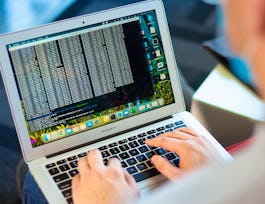In this course -- through a combination of video lectures, demonstrations, and hands-on practice -- you’ll learn about the main components of an operating system and how to perform critical tasks like managing software and users, and configuring hardware.



Operating Systems and You: Becoming a Power User
This course is part of Google IT Support Professional Certificate

Instructor: Google Career Certificates
Top Instructor
Sponsored by Coursera Learning Team
556,235 already enrolled
(28,445 reviews)
Skills you'll gain
- File Systems
- Windows PowerShell
- Microsoft Windows
- Software Installation
- Computer Systems
- Windows Servers
- Computing Platforms
- Linux
- File Management
- System Configuration
- Systems Administration
- Unix Shell
- Linux Administration
- Operating Systems
- Linux Commands
- Command-Line Interface
- Unix
- Package and Software Management
- System Software
- OS Process Management
Details to know

Add to your LinkedIn profile
17 quizzes, 1 assignment
See how employees at top companies are mastering in-demand skills

Build your Support and Operations expertise
- Learn new concepts from industry experts
- Gain a foundational understanding of a subject or tool
- Develop job-relevant skills with hands-on projects
- Earn a shareable career certificate from Google


Earn a career certificate
Add this credential to your LinkedIn profile, resume, or CV
Share it on social media and in your performance review

There are 6 modules in this course
Welcome to the Operating Systems course of the IT Support Professional Certificate! In the first module of this course, we will cover the basics of Windows and Linux operating systems (OS). We will learn about how directories and files work in Windows and Linux OS. You will also learn practical ways to manipulate files and directories in the Windows graphical user interface (GUI), Windows command line interface (CLI), and Linux shell. By the end of this module, you will interact with files and directories and perform basic text manipulation in Windows and Linux OS.
What's included
32 videos10 readings2 quizzes1 assignment2 app items
In the second module of this course, we'll learn about configuring users and permissions in Windows and Linux OS. As an IT Support Specialist, it's important to know how to grant the appropriate permissions to users and groups for both Windows and Linux OS. By the end of this module, you will know how to add, modify, and remove users for a computer and for specific files and folders by using the Windows GUI, Windows CLI, and Linux shell.
What's included
16 videos7 readings2 quizzes2 app items
In the third module of this course, we'll learn about package and software management in Windows and Linux OS. It's important to know how package installs work and how devices and drivers are managed within these operating systems. We will also learn about different packaging and file compression methods. By the end of this module, you will know how to create, update, and remove software by using the Windows GUI, Windows CLI and Linux shell.
What's included
16 videos20 readings4 quizzes2 app items
In the fourth module of this course, we'll learn about how filesystems work for Windows and Linux OS. We'll learn about filesystem types and why they're different for certain OS. We'll learn about disk partitioning and virtual memory and why these are so important for an IT Support Specialist's role. We'll also cover ways mount and unmount filesystems, read disk usage, and repair filesystems. By the end of this module, you will partition and format a disk drive yourself in both Windows and Linux.
What's included
16 videos12 readings2 quizzes2 app items
In the fifth module of this course, we'll explore process management. As an IT Support Specialist, it is important to use system tools to read and understand process statuses of machines. We will cover ways to start and terminate a process in Windows and Linux. We will also apply troubleshooting tools to solve problems with processes and resources. By the end of this module, you will use Windows and Linux commands to do practical process maintenance.
What's included
14 videos11 readings4 quizzes2 app items
Congratulations, you've made it to the final module in the course! In the last module of this course, we will cover some of the practical aspects of operating systems that you'll use all the time in IT Support. We will cover remote access and how to troubleshoot a computer from afar. We'll explore virtualization tools to manage and remove virtual instances, use logs for system monitoring, and show you a few different techniques for OS deployment. By the end of this module, you will apply all the skills from this course to debug some issues within Windows and Linux OS. Good luck!
What's included
16 videos14 readings3 quizzes2 app items
Instructor

Offered by
Why people choose Coursera for their career




Learner reviews
28,445 reviews
- 5 stars
77.35%
- 4 stars
16.60%
- 3 stars
3.69%
- 2 stars
1%
- 1 star
1.33%
Showing 3 of 28445
Reviewed on Jun 3, 2018
Should of separate the lessons in a way where it compliments one another. Windows by itself and Linux by itself instead of mixing it one after another (Windows then Linux). But either way, good videos
Reviewed on Apr 3, 2020
It is a very thorough and comprehensive course. It does have a lot of supplemental readings that may be out of date because it is 3 years old. Some of the commands are for Windows 8, not Windows 10.
Reviewed on Dec 27, 2020
This course was very informative and challenging. I really appreciate the way the course was put together. It would be ore helpful if the links to the readings were from material other than Wikipedia.
Recommended if you're interested in Information Technology

Dartmouth College

Illinois Tech

Open new doors with Coursera Plus
Unlimited access to 10,000+ world-class courses, hands-on projects, and job-ready certificate programs - all included in your subscription
Advance your career with an online degree
Earn a degree from world-class universities - 100% online
Join over 3,400 global companies that choose Coursera for Business
Upskill your employees to excel in the digital economy




